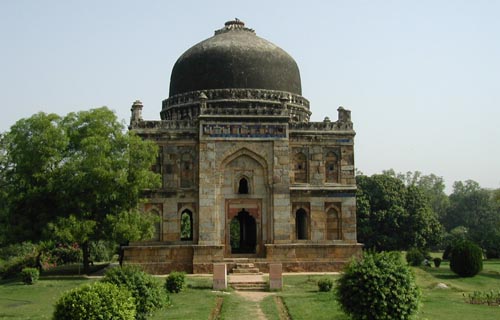Shish Gumbad

Information on Shish Gumbad (New Delhi) - History & Architecture
The Shish Gumbad is situated amidst the luxuriant green and unreserved locales of the well-known Lodi Gardens in New Delhi. This is the crypt of the last tomb of the Sultan dynasty's period. This tomb is of Mohammed Shah. Through an architectural viewpoint of this crypt follows the prototype of the one which is fundamentally used in a large amount of the Lodi tombs with a double storied manifestation and is similar to the cottage of the Bara Gumbad mosque in its structure. The upper limit of the testimonial is garlanded with incised display work containing flower-patterned designs and Quranic inscriptions. The testimonial is luxuriously garlanded with blue tiles and is one of the most tourist attraction places.
Shish Gumbad History
The crypt of Mohammed Shah was built in 1444 by Ala-ud-din Alam Shah as an acknowledgment to Mohammed Shah.
The tomb of Mohammed Shah is noticeable from the road, and is the original construction in the gardens. The structural design is characterized by the octagonal chamber, with stone Chhijjas on the top and guldasta on the corners.
Another tomb inside the gardens is of Sikander Lodi, which is alike to Mohammed Shah's tomb, even if with no chhatris. It was built by his son Ibrahim Lodi in 1517, the final of Sultan of Delhi from Lodi dynasty, shortly he was defeated by Babur. His tomb is often mistaken to be the Shish Gumbad, and is located in close to the tehsil office in Panipat. It is uncomplicated rectangular formation on a lofty podium. The crypt was reconstructed by the British, and a message mentioning Ibrahim Lodi's conquer by the hands of Babur and the restoration was incorporated in 1866. There are three vaulted mosque, neighboring to Bada Gumbad, Lodhi Gardens.
Beneath the Mughals major restoration would habitually take place depending on what circumstances they would make use of the gardens.
After the 15th century Sayyid and Lodi dynasties, two villages grew just about the monuments; however the villagers were reestablished in 1936 in order to generate the precincts. During British Raj it was landscaped by Lady Willingdon, companion of Governor General of India, and named the 'Lady Willingdon Park. In 1947, subsequent to self-determination, it was specified its current name, Lodi Gardens. During the point in time Stein also made a glasshouse inside the park.
Shish Gumbad Architecture
In the heart of the precincts is the Bara Gumbad. It consists of a bulky rubble-construct dome, it is not a tomb but a doorway to a close three vaulted Masjid or the Mosque, which was built in year 1494 at the stage of the sovereignty of Sikander Lodi, there is a dwelling neighboring a innermost courtyard, where there is a water tank. Reverse to the Bara Gumbad is the Shish Gumbad for the glassy tiles used in during its edifice.
The garden has the watercourse which connects the Yamuna River to Sikandar Lodi's tomb. The vault still has the fortifications enclosing it. Close by to Sikander's tomb is the Athpula Bridge, and is the preceding of the buildings in Delhi, which was built at the time of the supremacy of Akbar. It consist of seven arches, amid which the fundamental one being the largest. Lodhi garden is the vital place for the safeguarding.
Shish Gumbad Structures inside
Muhammad Shah's Tomb
It is positioned in the southwestern division of the garden. Inside the tomb there are 8 graves of which the fundamental one is said to be the grave of Muhammad Shah, the third monarch of the Sayyid dynasty. The exquisiteness of this tomb lies in its symmetry, the uttermost lotus and adornment on the domes.Bara Gumbad and Masjid
This four-sided figure or the structure of the tomb surmounted by a hefty dome, is to be found 300 meters northeast of Muhammad Shah's tomb. There are facades and turrets and was allegedly built at the control of Sultan Sikandar Lodi. The record says that, the internal of the tomb had eye-catching stuccowork and paintings.Zheesh Gumbad
It is about few meters to the north of Bara Gumbad Mosque. It is also known as glassy dome' since it has attractive blue tiled embellishment which remains only in traces on top of the main frontage.Thus the exceptional architectural beauty and the historical impotance of the Shish Gumbad, even today lure the visitors from across India.
- Andaman Nicobar Monuments
- Andhra Pradesh Monuments
- Assam Monuments
- Bihar Monuments
- Chhattisgarh Monuments
- New Delhi Monuments
- Goa Monuments
- Gujarat Monuments
- Haryana Monuments
- Himachal Pradesh Monuments
- Jammu and Kashmir Monuments
- Karnataka Monuments
- Kerala Monuments
- Madhya Pradesh Monuments
- Maharashtra Monuments
- Odisha Monuments
- Punjab Monuments
- Rajasthan Monuments
- Tamil Nadu Monuments
- Telangana Monuments
- Uttar Pradesh Monuments
- West Bengal Monuments